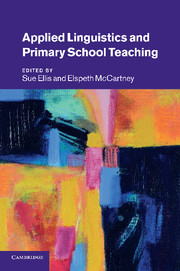Book contents
- Frontmatter
- Contents
- List of figures
- List of tables
- Notes on contributors
- Preface
- Editors' notes and conventions
- Introduction
- Part I Policy and diversity in the twenty-first-century primary school
- Part II The range and focus of applied linguistics research
- Introduction to Part II
- 6 Grammar for designers: how grammar supports the development of writing
- 7 The use of corpus-based approaches in children's knowledge about language
- 8 Words and pictures: towards a linguistic understanding of picture books and reading pedagogy
- 9 From storytellers to narrators: how can the history of reading help with understanding reading comprehension?
- 10 Talk about text: the discursive construction of what it means to be a reader
- 11 Why we need to know about more than phonics to teach English literacy
- 12 Understanding children's reading comprehension difficulties
- 13 Classroom discourse: the promise and complexity of dialogic practice
- 14 Pedagogy and bilingual pupils in primary schools: certainties from applied linguistics
- Part III Empowering teachers and teachers' use of knowledge
- References
- Index
6 - Grammar for designers: how grammar supports the development of writing
Published online by Cambridge University Press: 26 April 2011
- Frontmatter
- Contents
- List of figures
- List of tables
- Notes on contributors
- Preface
- Editors' notes and conventions
- Introduction
- Part I Policy and diversity in the twenty-first-century primary school
- Part II The range and focus of applied linguistics research
- Introduction to Part II
- 6 Grammar for designers: how grammar supports the development of writing
- 7 The use of corpus-based approaches in children's knowledge about language
- 8 Words and pictures: towards a linguistic understanding of picture books and reading pedagogy
- 9 From storytellers to narrators: how can the history of reading help with understanding reading comprehension?
- 10 Talk about text: the discursive construction of what it means to be a reader
- 11 Why we need to know about more than phonics to teach English literacy
- 12 Understanding children's reading comprehension difficulties
- 13 Classroom discourse: the promise and complexity of dialogic practice
- 14 Pedagogy and bilingual pupils in primary schools: certainties from applied linguistics
- Part III Empowering teachers and teachers' use of knowledge
- References
- Index
Summary
Introduction
The mechanic should sit down among levers, screws, wedges, wheels etc. like a poet among the letters of the alphabet, considering them as the exhibition of his thoughts, in which a new arrangement transmits a new Idea to the world.
(Robert Fulton – nineteenth-century engineer)A synergy between the work of a mechanic and the work of a writer is not the most obvious one, perhaps, yet Robert Fulton's analogy (Barlex and Givens 1995: 48) between the mechanic and the poet is an apt one. Both have to create products from the materials available, be that physical materials or linguistic resources; both have to test things out to see how they work; both have to make choices and decisions about the purpose of their work; and both have to evaluate their work critically before presenting it to the world as a new creation. At the heart of this creative activity is the concept of design. This chapter sets out to illustrate how, within a theoretical framework that conceives of writers as designers, linguistic resources and linguistic understanding play a crucial role in supporting the development of design capability in writing.
Writers as designers
I should like to lay the foundation for this chapter by elaborating the framework of writers as designers before narrowing the focus more specifically to the role of grammar and linguistics in a pedagogy of writing.
- Type
- Chapter
- Information
- Applied Linguistics and Primary School Teaching , pp. 81 - 92Publisher: Cambridge University PressPrint publication year: 2011
- 7
- Cited by



